The Formation of Lab-Created Diamonds Explained
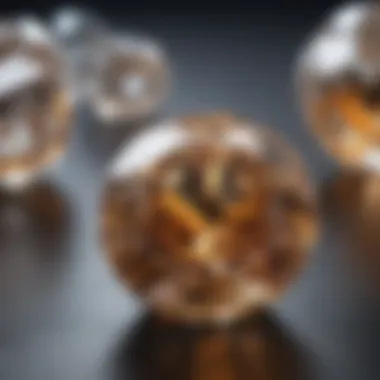
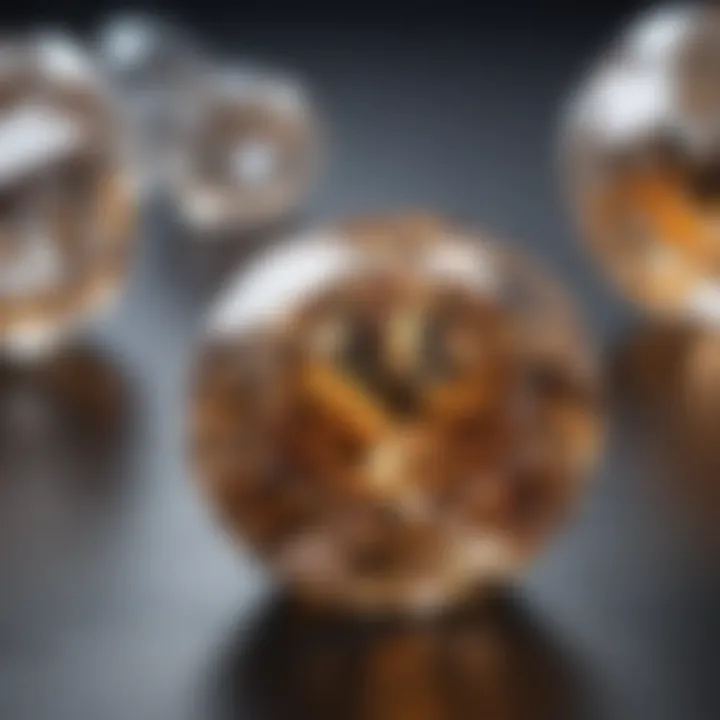
Intro
In the ever-evolving world of gemstones, lab-created diamonds have emerged as a fascinating subject worthy of exploration. As technology advances, the methods to grow diamonds in a controlled environment have become increasingly sophisticated, delivering products that mirror their natural counterparts in beauty and quality. Understanding the processes involved in creating these remarkable gems not only appeals to enthusiasts and collectors but also raises crucial discussions regarding sustainability and ethical sourcing in the jewelry industry.
This article intends to delve deep into the formation of lab-created diamonds, presenting a clear picture of how these exquisite gems come to life. We'll explore scientific principles, historical significance, and the intricate steps from formation to refinement. As we navigate this path, we will also touch on ethical implications and future trends, offering a comprehensive perspective for jewelry designers and geology aficionados alike.
Gemstone Overview
Definition and Origins
Lab-created diamonds, also known as synthetic diamonds or lab-grown diamonds, are genuine diamonds that are produced in a laboratory setting, rather than being mined from the Earth. The primary methods used for creating these stones involve High-Pressure High-Temperature (HPHT) and Chemical Vapor Deposition (CVD). Both techniques aim to replicate the natural processes that occur deep within the Earth, yielding diamonds that are chemically and physically identical to those formed over millions of years.
Historical Significance
The journey of lab-created diamonds began in the mid-20th century. Early experiments aimed to grow diamonds artificially were somewhat rudimentary and met with limited success. Over the decades, advancements in technology and understanding of crystallography paved the way for more efficient production methods. Today, lab-grown diamonds have gained significant traction in both consumer markets and among jewelers.
Their historical significance is also tied to the ongoing conversation about ethical mining practices. The advent of lab-grown diamonds presents a unique alternative, offering consumers a guilt-free option that sidesteps the problematic narratives often associated with diamond mining.
Gemstone Properties
Hardness and Durability
One of the defining characteristics of any diamond is its hardness. On the Mohs scale of mineral hardness, lab-created diamonds rank a full 10, the highest possible score, making them the hardest natural substance known to man. This exceptional durability makes them resistant to scratches and wear, contributing to their desirability in engagement rings and other jewelry.
Color and Clarity
Lab-grown diamonds can be produced with a remarkable range of colors, from colorless to shades of yellow, blue, and even pink. The color saturation and clarity often match or exceed those of naturally mined stones. Many consumers appreciate the ability to select diamonds based on personal preference, without the premium price tag often associated with rare colors in natural diamonds.
Prelude to Lab-Created Diamonds
The world of lab-created diamonds beckons with a promise that stands at the crossroads of science and beauty. Understanding lab-created diamonds is not simply a matter of grasping their unique formation process; it’s essential for understanding their place in the jewelry market, the environmental implications of their production, and the shifting preferences of consumers. Not only can these diamonds shine with undiminished brilliance, but they are also often perceived as more ethical and eco-friendly than their mined counterparts.
This section aims to elucidate the many facets of lab-created diamonds, diving into their definition and the historical context behind their production. Beyond examining the scientific marvel involved, we will peel back at the social implications and benefits, making a compelling case for why they are gaining traction among gemstone enthusiasts, jewelry designers, and those who value sustainability in their purchases.
Definition and Overview
Lab-created diamonds are scientifically identical to natural diamonds, yet they originate from completely different sources. As the name suggests, these diamonds are formed in controlled environments using advanced technology, which replicates the natural conditions under which diamonds form deep within the Earth.
To put it plainly, lab-created diamonds are composed of carbon atoms arranged in a crystal structure, just like natural diamonds. The principal difference lies in how they are produced. Through methods such as High Pressure High Temperature (HPHT) and Chemical Vapor Deposition (CVD), these stones are synthesized under precise conditions, yielding gems that can rival the allure of those mined from the ground.
A key point to note is that lab-created diamonds are generally more affordable than their mined counterparts, making them an appealing choice for consumers who want beauty without breaking the bank. Furthermore, they are virtually indistinguishable from natural diamonds without specialized testing, allowing them to maintain a significant level of prestige.
Historical Context
The journey of lab-created diamonds began not merely as a quest for beauty but as an exercise in scientific exploration. The first lab-created diamonds were synthesized back in the 1950s. Using the HPHT method, researchers successfully created diamonds that mimicked their natural relatives albeit at lesser quality in the early attempts.
However, advancements in technology soon led to improvements in quality. The turn of the millennium witnessed the emergence of the CVD method, changing the game for lab-created diamonds and marking a significant milestone. With this approach, crystals grew layer by layer, yielding gems that closely resembled their natural siblings in both appearance and structure.
Today, lab-created diamonds represent a substantial segment of the gemstone market. Their rise in popularity reflects a shifting perception where consumers value sustainability, ethical considerations, and modern craftsmanship, paving the way for a future where lab-created diamonds could hold an esteemed position alongside traditional mined gems.
"Lab-created diamonds embody a harmonious blend of artistry and science, paving the path for ethical choices in a world where sustainability matters."
In summary, the importance of lab-created diamonds expands beyond mere aesthetics. By understanding their definition, historical background, and significance, enthusiasts and consumers can engage more deeply with these remarkable gems, fostering an appreciation that goes beyond surface sparkle.
Scientific Basis of Diamond Formation
Understanding the scientific basis of diamond formation is pivotal to comprehending how lab-created diamonds achieve their remarkable qualities. This section unveils the intricate processes and fundamental principles that make these diamonds tick. The discussion paves the way to appreciate not only the similarities but also the subtle differences between natural and lab-grown diamonds, shedding light on their unique attributes.
Natural vs. Lab-Created Diamonds
At first glance, distinguishing between natural and lab-created diamonds might seem like comparing apples and oranges — they’re both diamonds, right? However, dig a bit deeper, and the differences start to shine through.
Natural diamonds form over billions of years under intense heat and pressure in the Earth’s mantle. The carbon atoms arrange themselves in a crystalline structure, resulting in the stones we find in nature. On the other hand, lab-created diamonds are made in a much shorter time frame, often mere weeks or months, through methods such as High Pressure High Temperature (HPHT) or Chemical Vapor Deposition (CVD).
Some would argue that lab-created diamonds lack the mystique of their natural counterparts. However, this view is becoming increasingly outdated. For many, the appeal lies in the controlled conditions of lab-grown diamonds, which allow for precision in size, clarity, and color.
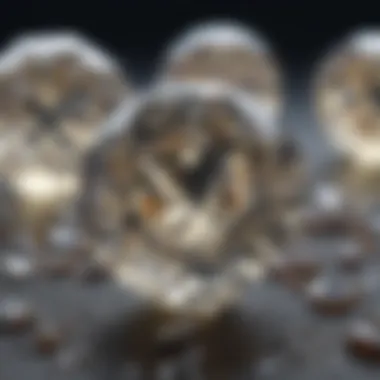
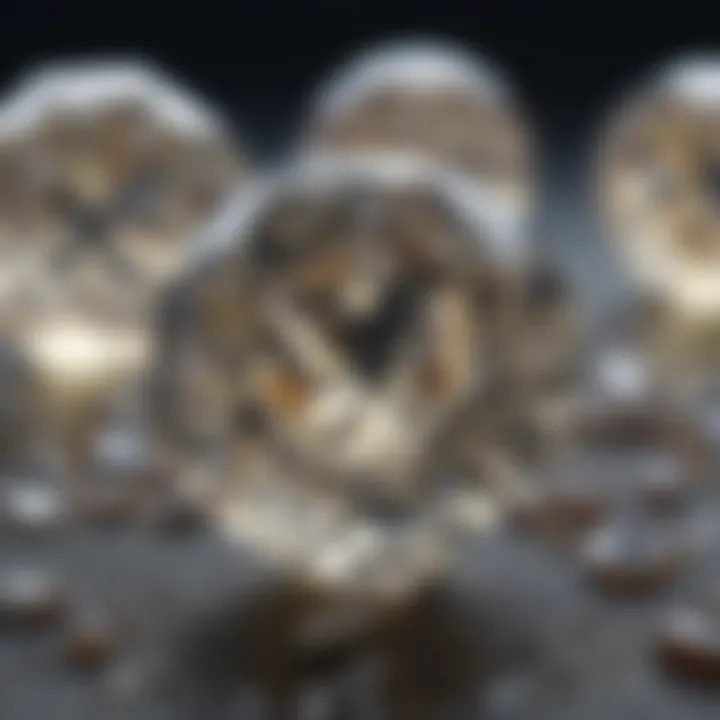
"The only difference might be their journey, not their essence."
In reality, these stones exhibit similar physical and chemical properties, which means they reflect light and sparkle in remarkably similar ways. The notion that one type is superior over the other tends to hinge more on personal sentiment than actual performance.
Chemical Composition
Let’s dive into the nitty-gritty of chemical composition. When it comes to diamonds, both natural and lab-created consist primarily of carbon atoms shaped into a unique structure. This is where their chemistry, albeit formed through different processes, becomes quite fascinating.
For both types of diamonds, each carbon atom bonds with four others forming a robust tetrahedral structure. This arrangement contributes to the exceptional hardness and brilliant shine synonymous with diamonds.
However, the environment in which they form influences their purity and characteristics. Natural diamonds may contain trace elements like nitrogen or boron, resulting in hues ranging from yellow to blue. Lab-created diamonds, meanwhile, can be produced to have a higher purity level, allowing for a more consistent color range.
Here are a few key points to consider regarding the chemical composition of diamonds:
- Carbon Atoms: Both types are made up of carbon atoms in a crystallized arrangement.
- Inclusives: Natural diamonds often contain impurities and inclusions, whereas lab-made diamonds tend to be purer.
- Color Variations: Natural diamonds may show various colors, often influenced by inclusions, while lab-created ones can be engineered for specific shades.
In summary, while the chemical makeup might be fundamentally similar, the journey each diamond takes greatly influences its characteristics. This intersection of science and artistry not only supports the beauty of lab-created stones but also elevates their status among gemstone enthusiasts and jewelers alike.
Major Production Techniques
The realm of lab-created diamonds hinges significantly on the major production techniques employed to replicate the conditions under which natural diamonds manifest. Understanding these methods sheds light on both the technical expertise required and the intrinsic value presented in lab-created gemstones. As the popularity of synthetic diamonds rises, it becomes essential to grasp how these techniques contribute to the characteristics of the resulting diamonds, be it in clarity, size, or overall aesthetic appeal.
High Pressure High Temperature (HPHT)
Process Overview
The High Pressure, High Temperature (HPHT) method mimics the natural conditions found deep within the Earth's mantle where diamonds are formed. In this process, carbon is subjected to extreme pressure—ranging from 5 to 6 GigaPascals—and elevated temperatures, reaching up to 1,500 degrees Celsius. The primary goal of HPHT is to rapidly convert carbon into diamond, utilizing a carbon source, usually graphite, placed next to a metal catalyst.
One of the key characteristics of HPHT is its effectiveness in producing gem-quality diamonds. Not only does it replicate natural formation conditions, but it also creates diamonds that can exhibit hue variation, often leading to unique, vivid colors once refined. However, this method isn't without its drawbacks; achieving the required pressure and temperature demands sophisticated and costly machinery, which may restrict its accessibility for smaller operations.
Applications in Industry
HPHT diamonds find numerous applications beyond the jewelry realm, significantly impacting industrial uses. Their hardness and thermal conductivity make them suitable for various tools, including cutting, grinding, and drilling applications where high endurance is essential.
The unique feature of using HPHT in an industrial context is that it enables the production of large volumes of uniquely tailored diamonds, depending on the desired application. Yet, while the initial investment may be steep, the long-term return can be substantial, especially as more industries recognize the quality and versatility of diamonds produced through these methods.
Chemical Vapor Deposition ()
Process Overview
The Chemical Vapor Deposition (CVD) process offers an alternative path to diamond creation with a distinctly different mechanism. In CVD, a gas mixture—rich in carbon—is introduced into a chamber, where it is activated by a heat source, often a microwave. This activation leads to the deposition of carbon atoms onto a substrate, which then gradually crystallize to form diamond layers.
CVD diamonds are often viewed as beneficial due to their controlled growth environment, allowing for specific manipulation of factors that influence the diamond's properties, such as size and purity. Furthermore, this technique allows for the growth of larger diamonds compared to HPHT, although the intricate nature of the process can lead to other challenges in achieving the perfect crystal structure.
Advantages and Challenges
The primary advantages of the CVD method are its flexibility and environmental considerations. It offers the capacity to produce diamonds with minimal waste and the ability to fine-tune various parameters to enhance quality, making it a popular choice among manufacturers aiming for precision craftsmanship.
However, CVD doesn't come without hurdles. The challenge lies in the fact that achieving uniformity across larger areas can be complex, occasionally leading to variations in texture and clarity. While some may find the CVD process more approachable, the detailed monitoring and adjustment needed throughout the growth phase can be more hands-on than in HPHT methods.
"Both HPHT and CVD techniques have shown significant advancements in recent years, enhancing the lab-grown diamond market's commitment to quality and sustainability."
In summation, the major production techniques of lab-created diamonds greatly influence their characteristics and applications. While HPHT and CVD each have their strengths and weaknesses, they underscore a critical advancement in creating ethical, high-quality diamonds that closely resemble their natural counterparts.
The Diamond Growth Process
The diamond growth process is a cornerstone in understanding how lab-created diamonds come to life. It forms the very basis of what distinguishes these synthetic gems from their natural counterparts. The importance of this topic in the discussion of lab-created diamonds cannot be overstated. It encompasses the initial phases of diamond creation through the controlled environments tailored for crystal growth. An intricate interplay of science and technology defines this process, paving the way for replicating nature’s own craftsmanship.
Within this section, emphasis will be placed on the seed crystal initiation, carbon source utilization, and growth environment control. Each of these elements introduces critical benefits and considerations. For enthusiasts, collectors, and designers alike, grasping the particulars of this diamond formation process not only enhances appreciation of these gems but also educates on their origins and values.
Seed Crystal Initiation
Seed crystal initiation stands as the first step in the spectacular journey of diamond creation. Think of a seed, the initial spark that ignites the transformation into a vibrant gemstone. The process begins with placing a tiny diamond seed into a high-pressure chamber. This seed acts as the nucleus around which carbon atoms will coalesce to form a larger crystal. The quality and properties of this initial seed significantly influence the final diamond's attributes, including clarity and size.
One of the fascinating facts about this phase is how meticulous conditions must be maintained. For instance, the choice of the seed material, often a synthetic diamond or a gem-quality natural diamond, can set the tone for the characteristics of the emerging diamond. The initiation phase may not be as glamorous as the end product, but without it, there would be no diamonds at all.


Carbon Source Utilization
After rooting the seed crystal, the next vital aspect revolves around carbon source utilization. To grow a diamond, carbon is an absolute necessity since it's the building block of these stones. In lab-created diamonds, various carbon sources can be harnessed. One common method involves using graphite as the primary carbon feedstock, while other scenarios might employ more refined hydrocarbons.
In the chemical vapor deposition (CVD) method, carbon-rich gases, such as methane, are introduced into the chamber. By breaking down these gases, scientists can control the flow of carbon atoms into the growth area around the seed. The selection of carbon source isn’t merely a matter of preference; it dictates the diamond's eventual qualities, including potential color and internal structure. Harnessing the right carbon source can mean the difference between a gem that's lackluster and one that truly shines.
Growth Environment Control
The essence of diamond growth heavily relies on a meticulously controlled environment. If one wants to raise diamonds, the conditions must mimic those found deep within the Earth—only under pressure and heat can these gems flourish. This control encompasses multiple factors: pressure, temperature, and gas composition, which must be meticulously calibrated to foster growth.
For instance, in the HPHT process, temperatures can soar to over 1,500 degrees Celsius while pressures can reach levels akin to those found at Earth's core. On the flip side, CVD may operate at lower temperatures but requires a precise mix of gases for optimal growth. Creating a stable environment means that any fluctuations—however slight—can impact the development of the diamond, leading to potential flaws or incomplete crystallization.
"Creating a thriving growth environment is like conducting an orchestra; every note must align to achieve the harmony of diamond perfection."
By focusing on the development process from seed crystal initiation to environment control, one can appreciate the scientific wonders that replicate nature's artistry. These phases not only enhance understanding but also reinforce the value behind lab-created diamonds, offering clarity amid the complexities of gem formation.
Post-Growth Treatments and Enhancements
The journey of lab-created diamonds does not conclude with their formation. In fact, what happens after the diamond growth process plays a significant role in defining the gem's final attributes, such as its appearance, brilliance, and overall marketability. Post-growth treatments and enhancements are essential for ensuring that these diamonds meet the aesthetic preferences of consumers and the rigorous standards of the jewelry industry.
Cutting and Polishing
Cutting and polishing are often where the magic really happens. The rough diamond, straight from the growth chamber, resembles a piece of unrefined stone rather than the sparkling gem its future owners crave.
This process requires both skill and precision. Jewelers assess the rough diamond for its best facets, taking note of inclusions and imperfections, which are critical in determining the optimal cut. The diamond must then undergo a series of cuts that maximize its reflection and refraction of light. Techniques vary, with the most popular being the round brilliant cut, known for its ability to reflect light in a dazzling way.
Features such as symmetry, proportions, and finish impact the stone's brilliance. When done correctly, it can take a relatively mundane stone and turn it into a true eye-catcher. Polishing is the final touch, giving the diamond its signature shine. The surface quality achieved through polishing can significantly affect the diamond’s value, making it not just a cosmetic issue but a financial consideration as well.
Color Enhancement Techniques
Another aspect of post-growth treatment involves color enhancement techniques, which aim to improve a diamond's hue. While many lab-created diamonds are nearly colorless, this isn't always the case. Sometimes a hint of yellow or brown tints the diamond's beauty.
There are several methods used for color enhancement:
- HPHT Treatment: High Pressure High Temperature treatment can alter a diamond's color, providing it with a more desirable appearance.
- Irradiation: This method uses radiation to change the diamond's color at a molecular level. While it's effective, the technique requires careful handling due to safety concerns.
- Laser Treatment: Focused lasers can also be used to enhance or even change a diamond's color. This method is often well-controlled and can yield stunning results.
It's crucial for consumers to be informed about these processes, as they may affect the diamond's value and desirability. A lab-created diamond that has been enhanced could offer an incredible aesthetic appeal while also ensuring ethical standards are met.
"Post-growth treatments can elevate a diamond's allure, but understanding these enhancements is key to appreciating the gem's true value."
In summary, the process of cutting and polishing, alongside color enhancement techniques, plays an undeniable role in the final presentation of lab-created diamonds. As technology evolves, so do the methods, allowing for an ever-growing variety of desirable attributes in these gems. This is an exciting time for gem enthusiasts and designers alike, as the possibilities seem practically limitless.
Identifying Lab-Created Diamonds
Understanding how to identify lab-created diamonds is crucial for various stakeholders in the gemstone industry. Jewelers, collectors, and even casual buyers need to discern between natural and synthetic diamonds for reasons ranging from authenticity to value assessment. Misinterpretations in diamond identification can lead to significant financial implications. In a marketplace where lab-grown options are increasingly viable, recognizing the differences helps maintain trust in the industry. The following sections dive into the methods used for testing and recognizing lab-created diamonds, and the characteristics that distinguish them from their natural counterparts.
Gemological Testing Methods
Gemological institutions employ several sophisticated testing methods to identify lab-created diamonds, ensuring accuracy and reliability.
- Spectroscopy: This method analyzes the light spectrum emitted or absorbed by a diamond, revealing its composition. Lab-created diamonds often show distinct spectral lines, different from those of natural stones.
- DiamondView Imaging: A highly refined imaging technique that employs ultraviolet light to distinguish characteristics found only in synthetic stones. It can visualize the crystal growth patterns effectively, showcasing the internal structure that helps identify the origin.
- Photoluminescence: This involves observing how a diamond interacts with light. Lab-created diamonds tend to reflect specific luminescent properties that can be detected through advanced testing equipment.
- Inclusion Analysis: Microscopists closely examine inclusions, the tiny flaws or minerals within a diamond. Certain types of inclusions are markers of synthetic diamonds, such as curved or distinct growth lines not commonly found in natural stones.
These methods collectively enhance the accuracy of identifying synthetic diamonds, establishing standards in a field that thrives on precision and reliability.
Differences in Appearance and Quality
While lab-created diamonds mirror natural ones in many aspects, subtle differences can often signify their synthetic origin. Here are some key points that distinguish them:
- Color: Lab-created diamonds can exhibit a wider range of colors due to controlled conditions during their formation. Colors tend to be more uniform, lacking some of the color zoning observed in natural diamonds.
- Clarity: On the whole, lab-grown diamonds generally boast higher clarity. This is a result of fewer blemishes formed due to the precise environment of their creation. Natural diamonds, as a contrast, often exhibit more inclusions and imperfections, which can add character but also may negatively affect their value.
- Cut: The technology available for cutting lab-created diamonds often allows for more precise shapes compared to natural diamonds. This can result in a high level of symmetry and light performance, making them exceptionally dazzling.
- Light Performance: Differences in how light interacts with lab-created versus natural diamonds can sometimes be detected by trained professionals, as lab-grown options might display a more consistent brilliance and fire based on the tight control of growth parameters.
In summary, while lab-created diamonds share much of their allure and beauty with natural diamonds, certain characteristics can set them apart. Understanding these distinctions is essential for anyone looking to navigate the complex diamond market.
Market Trends and Consumer Perceptions
Understanding the dynamics of market trends and consumer perceptions around lab-created diamonds is paramount, especially in a landscape that is swiftly changing. As the world becomes more eco-conscious, and as the millennial and Gen Z generations take on greater purchasing power, insights into how these segments view lab-created diamonds shed light on the industry's future.
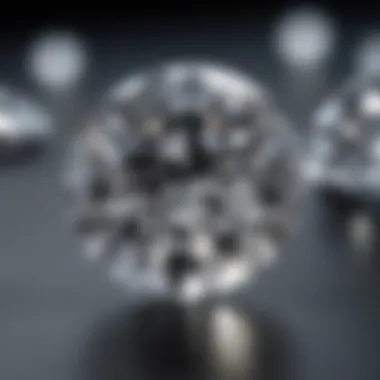
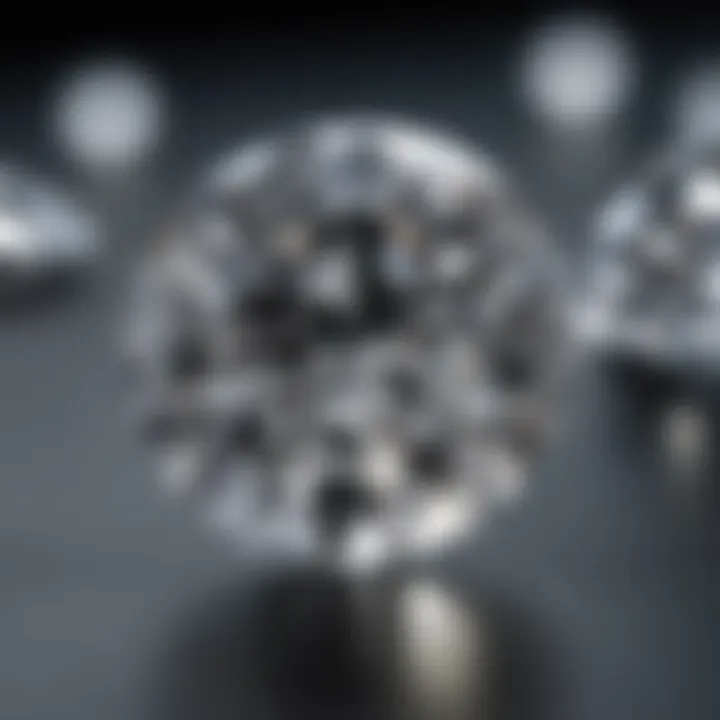
One key element driving this shift is the increasing awareness regarding the environmental footprint of mining natural diamonds. Many consumers today are deeply concerned about the origins of their purchases and how these choices impact the planet. For instance, lab-created diamonds usually have a much lower environmental impact and tend to utilize resources more sustainably than their mined counterparts.
The benefits of choosing lab-created diamonds extend beyond just ethics. They often offer superior value in terms of size and quality for the price, making them appealing to discerning buyers looking for affordability without sacrificing beauty.
Consumer Demand Analysis
Consumer demand for lab-grown diamonds has seen a notable uptick in recent years, driven by a combination of socio-economic factors and consumer preferences. More often than not, price-conscious buyers are inclined to gravitate towards these diamonds since they typically cost 20% to 40% less than natural ones. This price advantage creates a substantial incentive, particularly for first-time buyers or couples looking for engagement rings.
In addition, social media plays a powerful role in this burgeoning trend. Platforms like Instagram and Pinterest allow consumers to explore designs and showcase their purchases, thereby influencing broader acceptability. Influencers often highlight the beauty of lab-created diamonds, normalizing their presence in various forms of jewelry.
Moreover, a growing number of retailers are dedicating themselves to this segment, offering customized solutions that cater to the desires of the modern shopper. As these products become more mainstream, we may witness a shift in how diamonds are perceived, leading to increased discussions around alternatives to traditional gems.
Environmental and Ethical Considerations
Lab-created diamonds resonate well with a demographic that prioritizes ethical consumption. There’s an intrinsic appeal derived from knowing that their purchase contributes to more sustainable practices in the jewelry industry. As consumers become more educated about the issues surrounding traditional diamond mining, which include labor exploitation and environmental degradation, lab-created alternatives emerge as a sound choice.
Importantly, companies are increasingly emphasizing these ethical aspects in their marketing strategies, ensuring that their products are not just visually appealing, but also aligned with a more humane approach to sourcing.
"The conscious consumer is no longer just a trend; it's a reality that shaped the diamond industry."
Additionally, concerns related to potential conflicts associated with mined diamonds also amplify the attractiveness of lab-grown options. The term "blood diamonds" signifies a darker side of the diamond trade, prompting many to seek out alternatives that assure ethical sourcing.
Future Outlook for Lab-Created Diamonds
As we gaze into the crystalline future of lab-created diamonds, it becomes increasingly evident that these gems are more than just a passing trend. Their emergence highlights a paradigm shift in how consumers perceive valuable stones. The upcoming sections articulate the significance of technological advancements and the evolution of market dynamics, both of which are instrumental in shaping the future of the diamond industry.
Technological Innovations
The realm of technology surrounding lab-created diamonds is blossoming with potential. Innovations in machinery, methods, and materials are advancing rapidly. For example, enhancements in the Chemical Vapor Deposition technique have enabled scientists to produce gems with superior quality and fewer inclusions. The algorithms that govern the growth process are also being refined to optimize size and shape.
Moreover, artificial intelligence is carving a niche in the gemstone industry. By analyzing vast datasets, AI can predict how different conditions affect diamond growth, leading to increased efficiency and quality. As this technology continues to mature, we might witness faster production cycles, which means that more diamonds can reach the market without sacrificing quality.
With these innovations at play, we can expect:
- More cost-effective production methods
- Improved color and clarity in diamonds
- Wider accessibility for consumers
However, technological growth comes with its challenges. As consumers become more educated, they may demand not just the beauty of the gem but also transparency regarding its creation. The key will be balancing innovation with ethical practices, ensuring that advancements do not compromise the integrity of the diamonds produced.
"The heart of innovation does not beat in isolation; it requires a conscious effort to align technology with sustainability."
Potential Market Evolutions
As lab-created diamonds gain more acceptance, the market landscape is likely to transform significantly. One notable shift that is already observable is the demographic change in the target market. Younger generations lean toward eco-friendly products and practices. This emphasis will likely accelerate the demand for lab-created stones, as they offer a guilt-free way to indulge in luxury.
Additionally, the pricing strategy of lab-created diamonds will probably undergo a change. As production becomes more efficient, a reduction in prices may attract a wider audience. Some potential market evolutions include:
- Increased direct-to-consumer sales through online platforms, making jewelry accessible to more individuals.
- Collaboration with major retailers, where lab-created diamonds are positioned alongside their natural counterparts, promoting educated consumer choice.
- Expansion into luxury markets, where exclusivity meets sustainability, appealing to affluent buyers who prioritize ethical consumption.
This evolving landscape opens doors for innovative designs and new business models. As companies adapt to these shifts, we may even see creative collaborations across industries, melding technology with artistry to deliver unique offerings.
As we contemplate the future, it’s crucial to remain mindful of how these developments will not just affect the market but also shift societal perceptions of value in the realm of gemstones. Understanding these trends can help investors, industry professionals, and enthusiasts alike position themselves strategically within this sparkling industry.
Closure
In wrapping up our exploration of lab-created diamonds, it’s clear that the significance of this topic stretches far beyond mere gemology. The advancements in technology and science reflected in these stones play an essential role in reshaping the landscape of the diamond market. Understanding the nuances of their formation provides a gateway into comprehending their impact on consumer behavior, ethical considerations, and environmental sustainability.
Recapitulating Key Insights
Throughout this article, we have traversed the multifaceted processes involved in the creation of lab-grown diamonds. To summarize:
- Scientific Principles: We examined the distinct methodologies, namely High Pressure High Temperature (HPHT) and Chemical Vapor Deposition (CVD), that mimic the natural formations of diamonds.
- Ethical Implications: Lab-created diamonds present a compelling alternative to mined diamonds, raising crucial questions about sustainability and ethical sourcing.
- Market Trends: Consumer perceptions have shifted significantly, leading to a growing demand for lab-created diamonds rooted in consumer awareness and preference for ethical practices.
- Future Innovations: The ongoing technological advancements promise even greater production capabilities and market integration.
This synthesis provides a clear view of how lab-created diamonds are not just a trend but rather a vital element of a larger conversation about luxury, ethics, and environmental responsibility in our society.
Final Thoughts on the Future of Diamonds
As we glance into the crystal ball of future developments in lab-created diamonds, one can’t help but feel a sense of optimism. With increasing awareness and acceptance among consumers, it’s safe to infer that lab-grown diamonds are on the brink of broader societal embrace. The emergence of newer technologies is likely to refine the processes further, enhancing their quality and reducing production costs.
Moreover, the conversation about gemstones is shifting. Consumers are looking for stones that not only offer beauty but also align with their values. As a result, the lab-grown diamond market is set to expand, with retailers increasingly featuring these gems in their offerings. This transformation paves the way for a future where the elegance of diamonds coexists with ethical sourcing and environmental sustainability.
In summary, the trajectory of lab-created diamonds is anything but predictable. However, what remains certain is their potential to redefine luxury for a conscientious generation.



